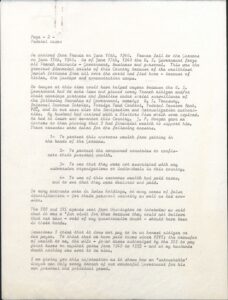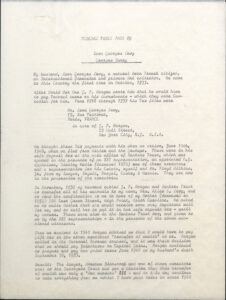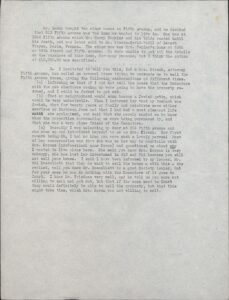


Georges Lurcy’s desire to assimilate into American society was most likely rooted in his experiences surrounding his immigration to the U.S. The Lurcys faced many stressful, and potentially life-threatening predicaments during the process of immigrating to escape the Nazis. Alice’s letter to the JP Morgan Bank shines light on the painstaking troubles of moving their lives from France to the U.S. and explains how they “fled from Hitler and the Gestapo,” along with the issues they encountered when trying to transfer their wealth to the U.S. The U.S. government froze all French accounts in 1940, and Alice exclaims that “this was the greatest financial crisis of this country because the wealthiest Jewish fortunes from all over the world had fled here – because of Hitler.” She goes on to describe how every French immigrant was under strict surveillance of many U.S. government financial branches, and how they resented this level of surveillance.
In order to transfer their wealth to the U.S., the Lurcys were forced to put many of their bank accounts into Swiss holdings, under false identities, and into Alice’s name to “protect this enormous wealth from getting into the hands of the Germans.” The Lurcys had to pay heavy taxes on the transfer of money into Alice’s name in the U.S., even though a court described the transfer as a “war measure.” Georges had earned his enormous wealth through his own invention, and grew up in a modest household. To have this self-earned wealth be on the brink of being stolen by the Nazis because of strict U.S. regulations or depleted by U.S. tax policy was surely threatening.
When Georges originally arrived in the U.S., his VISA soon expired, and he was forced to leave then re-enter. We were not able to find any information on where exactly he went, but we infer that this must have been an alarming experience, especially if he was forced to go back to Europe. The letter says that in order for him to re-enter the U.S., Alice had to prove she could financially support him. These negative experiences associated with transferring his wealth from Europe to the U.S. most likely played a role in Georges’ Jewish identity disputation, considering his immigration and the problems that stemmed from it were the direct result of escaping the Holocaust.

In a letter to her lawyer, Dr. Rodner, Alice describes how another attorney approached her to advise her to sell the Lurcys’ Fifth Avenue house after Georges passed away. The attorney’s reasoning was because “the neighborhood would soon become a Jewish ghetto, which would be very undesirable.” Considering how New York has historically had a large Jewish population, the antisemitism stemming from the lawyer’s remark shows how deeply embedded anti-semitism was in society. It might have been advantageous for the Lurcys to hide their Jewish identity when purchasing a house in an upper-class neighborhood in New York since it seems as though there was a negative sentiment towards Jews moving into certain neighborhoods in the city.
In addition to possibly facing discrimination in New York neighborhood, Georges may have also assimilated to avoid discrimination against Jews in American universities. Until the 1950s, many universities tried to limit Jewish representation. Immediately post-World War II, Jews campaigned against using religious criteria when evaluating applications at universities, though this was mainly centered in the North at universities such as Cornell and Columbia. Considering George decided to attend the University of North Carolina located in the rural South, I infer that he may have been driven to assimilate for educational mobility (Richard 2006).
Reference:
Alba, Richard. “On the Sociological Significance of the American Jewish Experience: Boundary Blurring, Assimilation, and Pluralism.” Sociology of Religion, vol. 67, no. 4, 2006, pp. 347–58, https://www.jstor.org/stable/25046754.